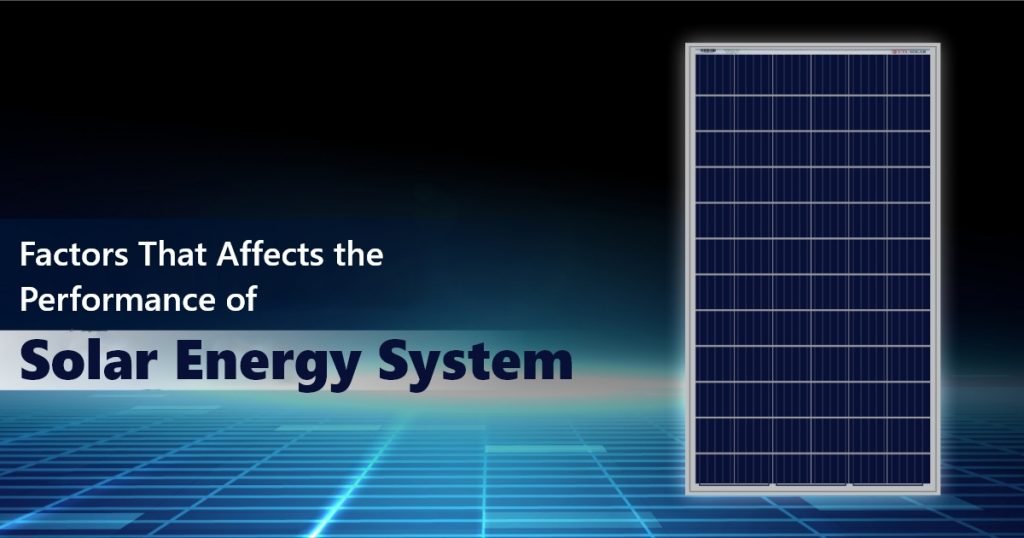Factors That Affects the Performance of Solar Energy System.

Many countries have realized that creating more energy will simply exacerbate the existing predicament as our planet moves toward a more unfavorable future climate. It doesn’t help that the majority of people still consume power generated by burning coal and fossil fuels.
The Solar Energy System has existed for a long time. However, due to the impending threat of climate change to the entire planet’s life, it has gotten increasing attention recently. More countries and utilities are now attempting to support it. Due to the abundance of sunlight, solar energy is the most popular renewable energy alternative among all others.
Factors Affecting Solar Panel Efficiency

There are some main factors that can affect the efficiency of any solar panel :
Temperature-
The effectiveness of Solar power installation changes depending on the temperature. The effects of high temperatures on performance are detrimental. As we all know, we calibrate the nominal power of PV modules indoors at 25°C using a typical sunshine intensity.
The heat dissipation circumstances are varied, and the real outdoor working temperature of the module is often higher than 25°C. We proposed the idea of Nominal module operating temperature to better compare the outdoor power generation of solar modules (NMOT).
Solar Shadings-
Solar PV panels are very vulnerable to solar shadowing. Total or partial shade has a substantial impact on energy delivery capability, potentially resulting in lower output and power losses. A solar panel’s cells are frequently connected in series to get a higher voltage and, as a result, a more appropriate output of power.
When shading occurs, however, this structure has several drawbacks. In fact, when a single solar cell is shaded, the unit that provides the least current determines the current of the entire string. When a cell is darkened, the entire series is shaded as well.
Location-
Not every location has the same amount of annual sunshine. In developing a cost-effective solar energy system for your use, determining the amount of solar radiation received in your house isolation is a difficult task.
Local weather, the time of year, and, most significantly, the latitude of your home or business are all indicators of isolation.
Also Read – Which States Have the Highest Solar Energy Potential in the USA?
Roof Orientation-
The Solar power installation must be positioned facing south, as the sun is constantly in the southern region of the sky. As a result, facing solar panels south is often the greatest technique for capturing the most amount of sunlight overall.
The south-facing solar panels should be tilted between 30 and 40 degrees, with the goal of ensuring that sunlight strikes the panels at a perpendicular angle, which produces the greatest energy. In northern latitudes, an edge along these lines also helps snow slide off solar panels more quickly throughout the winter.
Soiling-
Material that collects on the surface of a solar energy system can restrict light from reaching the solar cells, consequently lowering the generated power. The amount of power lost as a result of soiling varies greatly depending on the type of soiling (such as dust or snow) and the frequency with which it is cleaned.
Also Read – Do you Really Need Snow Guards for Solar Panels in California?
Dust accumulated on the module’s light-receiving surface reduces the light transmittance of the surface initially. Second, it will alter the incident angle of a portion of the light, causing the light to spread unevenly across the glass cover. Find excellent solar companies in California.
Age-
The older solar panels become, the less electricity they produce. The performance decline is typically estimated to be around 0.5 percent per year.
Aside from the aforementioned factors, a solar system’s energy production is influenced by a number of other factors. For instance, the system’s design and installation (tilt, orientation, stringing configuration, and so on), battery efficiency, and so on.
Also Read – What is Off-Grid Solar Energy and How it Works.
Final words-
It’s crucial to keep in mind that the process of generating electricity from solar energy isn’t perfect. Temperature, soiling, and shading, as well as losses in the electrical components, can all have an impact on the efficiency of a PV system.
Even the best solar panels, with adequate design, can have their efficiency considerably impacted by environmental conditions if the above considerations are not taken into account. If you want to get solar installed get in touch with top-class Solar Panel Installer in Fresno.